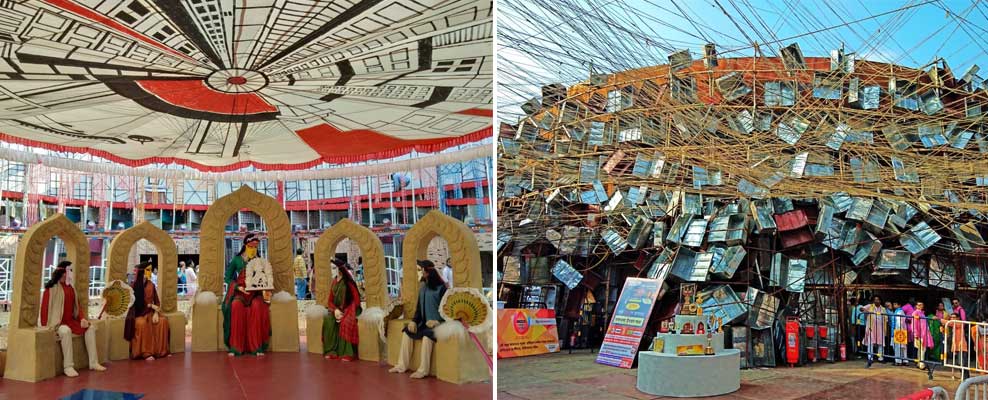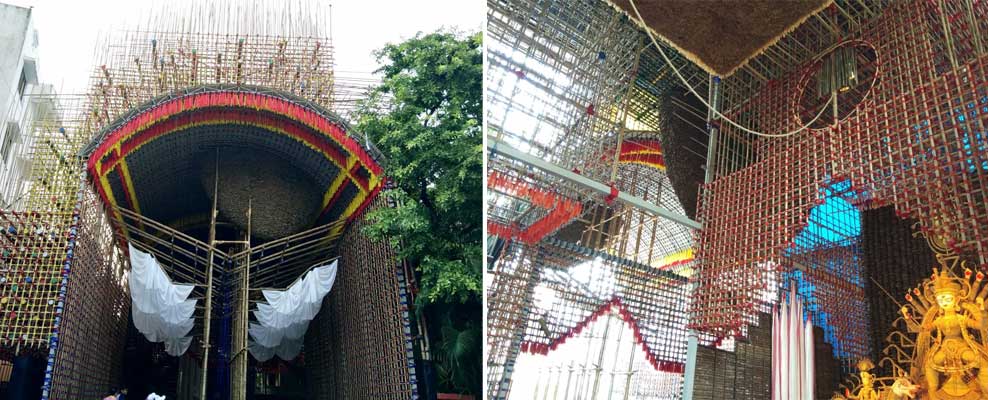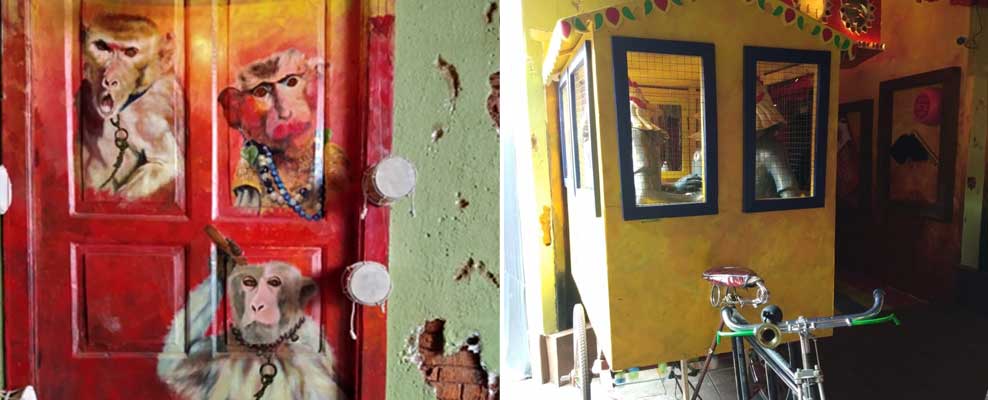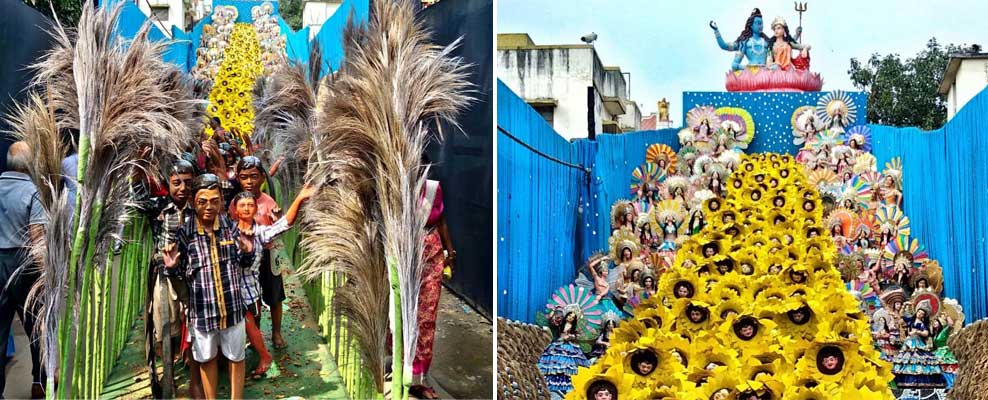From Rachel Fell McDermott’s book Revelry, Rivalry and Longing for the Goddesses of Bengal one learns that Durga Puja although having been celebrated by Kansanarayan (zamindar of Terpur, Rajshashi) in 1583, Savarna Roychaudhuri’s in 1610, Govindaram Mitra (one of the first Babus) in 1720, and Raja Nabakrishna Deb in 1757, became an entrenched cultural practice in Kolkata amongst the entrepreneurial rich in the second half of the 19th century. Many persons who rose to financial eminence at that time were Kayasthas and the fact that performing Durga Puja did not demand any prescriptions of caste, allowed men such as Akrur Datta (owned the first shipping line), Radhanath Basu Mallick (the moving spirit behind the construction of the Hooghly Dockyard in 1842), Gurucharan Pramanik (lined the bottoms of ships with brass) and the Kailas Boses of Hatkhola (pioneered steam communication on the Hooghly) to gain further social prestige and prominence by instituting Durga Pujas in their houses.
Other families who invited the British to Pujas in their houses include the Shovabazar Debs, Pathuriaghata’s Baisnavdas and Nilmani Mallik, Borobazar’s Nimaichand Mallik, Austosh Dey of Simla, Sukahmoy Ray of Sukhbazar, Darpanarayan Thakur, Benoylal Tagore and many others.
From McDermott’s book one also learns about the beginnings of ‘barowari’ puja in Kolkata.
In 1820 the Calcutta Journal explained the mechanism of such celebrations: − five to six Brahmans get together, form a committee, collect subscriptions, set up a ‘temporary shed”, construct an idol and engage singers.
By 1920, the sarvajanin puja arrived which took the festival to the streets, ‘with their illuminations, temporary houses for the goddess, processions and gatherings, and free musical entertainments.
Theme puja today is a feature of the sarvajanin pujas. Today the Durga image travels from patua (mud artisans) neighborhoods like Kumartuli to the thakurdalans of aristocratic families and to the sarvajanin puja pandals.
In the last ten to fifteen years, ‘Theme Puja’ has become a prominent feature of sarvajanin pujas of Kolkata. In an interview I took of Gauranga Kuila and Debaprasad Hazra who were the artists behind the Tridhara, Mudiali and Barisha Sarvajanin and Budoshibtala Pujas this year, Gauranga Kuila spoke at length about what ‘theme’ meant. Although admitting that it was hard to come up with a flawless dictionary meaning of the term, theme meant a ‘bhavna’ (‘image’, ‘feeling’, ‘metaphor’, ‘symbol’). Theme brought in an ‘intellectual component’ to the ‘feeling’ of a general celebration.

Some of the ‘theme’ Pujas of Kolkata this year. I will start with Naktala Udayan Sangha which highlighted Kaal or Time as the greatest and most abiding reality of human lives and of the cosmos. Time orders existence through the past, the present and the future and its power in thus ordering life must be acknowledged. Inextricably linked to the notion of Time is the notion of Movement which too is the other great reality of the cosmos. All human experience and cosmic realities can be charted/interpreted through the graphs of Time and Movement.

The ‘theme’ highlighted by Jodhpur Park 75 Pally, was Mayar Bandhan or the Bind of Maya. The artist was Bhabatosh Shutar. The theme highlights creative fantasy at the heart of existence. Although their theme statement speaks of Durga as Maya and the ultimate knower of the field of her beauty manifested in pandal making, image configuring and designing, what is actually left out is the richness and the power of the human imagination that imagines the Devi as such, through the many modes in which she may be imagined and created.
]

The ‘theme’ of Bhawanipore 75 Pally was ‘As one looks back into the diaries of the past, a page answers back’. In the 54th year of the celebration of this puja, the artist Biman Saha has explored this meditative and poetic subject with depth and sincerity. The question that this theme throws out to pandal goers is ‘What did we want when we were young and what do we want now?’ This brings in questions of childhood versus youth, youth versus middle age and middle age versus old age, making us examine our life choices and decisions.

Dum Dum Tarun Dol performed a very innovative, powerful and socially relevant theme, this year. It was on the powerful and heart wringing ‘theme’ of child exploitation and labor. Pandal goers would perforce have to confront this disturbing and persistent social and class oppression. Gansha, a young boy from the village, having lost both his parents comes to the city to work. He has to leave school to do this. He starts working in a tea stall. Needless to say it is a life of back-breaking labor and very little child-like joy and delight. The onset of the Pujas reminds him of his mother, his village home, the Kaash flowers and how Puja meant a holiday from school work. He prays to Durga that since she is the Mother of All, she should free him from the bonds of child labour. The theme deserves accolades for its emotional and affective reach.
The environmental and ‘natural’ issue surfaced this year again, in the Barisha Sarvajanin Puja, powered by the creative vision of Gauranga Kuila and Debaprasad Hazra. This puja highlighted the Andaman Islands Scheduled Tribes, the Jarowa, whose lives remain unspoilt by excessive civilization and comfort. As much as it is important to move away from barbarism, civilisation has its own barbaric face, which may be seen in the way cyborgs and artificially intelligent machines have almost put human emotions and feelings in jeopardy.
‘Theme’ Puja remains one among the many symphonic variations of the massive and extraordinary celebration of life, living, culture, economics, spiritual impulse, Shakti sadhana, reaffirmation of Shakta scripture and epistemology, song, music, and dialogues of classical and folk art, that is Durga Puja. It is a new strand worth paying attention to and documenting, as both historical record and artistic practice of how a nation/region imagines itself within a celebratory mode which highlights woman at the center of creation, nation, society and family.
Photo Credits: Ayan Chattopadhyay
